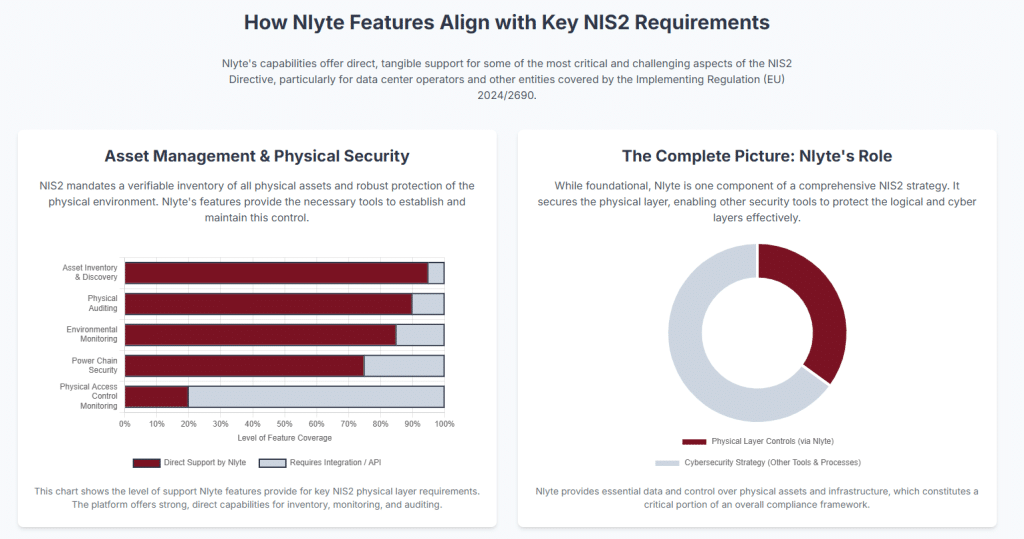Why NIS2 Makes Physical Infrastructure Security Non-Negotiable
Published on June 11, 2025,
by
The clock has been ticking, and for many European organizations, the alarm is about to go off. The EU’s NIS2 Directive, with its October 2024 transposition deadline, isn't just another incremental update to cybersecurity regulations. It’s a seismic shift, creating a new era of cyber accountability that extends far beyond the digital realm and deep into the physical world of your IT infrastructure.
For years, cybersecurity conversations have been dominated by firewalls, intrusion detection, and endpoint protection. But NIS2 makes one thing crystal clear: if you don't have a verifiable grip on your physical assets and the environment they live in, your compliance strategy is built on a dangerously incomplete foundation. With penalties reaching as high as €10 million or 2% of global turnover, ignoring this is a risk no business can afford.
The NIS2 Reality Check: It’s All Connected
The directive significantly expands its scope to cover 18 critical sectors, from energy and transport to digital infrastructure and manufacturing. It imposes a strict, multi-stage incident reporting timeline—forcing organizations to issue an "early warning" within just 24 hours of a significant incident.

Most importantly, it mandates an "all-hazards approach" to risk management. This single phrase is a game-changer. It legally requires organizations to protect their network and information systems not just from malware and hackers, but also from failures in their physical environment. The directive explicitly calls out asset management and access control policies as baseline security measures every in-scope organization must have.

For data center operators, cloud providers, and other digital infrastructure entities, the message is even more direct. The associated Implementing Regulation (EU) 2024/2690 lays out detailed requirements for physical security, environmental monitoring, and asset inventory management. The days of treating your data center as a separate world from your cybersecurity strategy are over.
Bridging the Gap: When Your Data Center Becomes a Compliance Tool
This new reality forces a crucial question: How can you prove you have control over thousands of physical assets, their power chains, their network connections, and the environment they operate in?
This is where Data Center Infrastructure Management (DCIM) evolve from operational nice-to-haves into strategic compliance necessities. A platform like Nlyte Software acts as the bridge between your IT, security, and facilities teams, creating a single source of truth for your entire physical infrastructure. It provides the visibility and control needed to answer the tough questions posed by NIS2.
Three Foundational Pillars for NIS2 Readiness
Think of building your NIS2 compliance strategy like constructing a house. You wouldn't build the walls without a solid foundation. Nlyte helps establish that foundation through three critical pillars:

1. Verifiable Asset Management
You can't protect what you don't know you have. NIS2 demands an accurate, up-to-date inventory of all assets supporting your critical services.
- How Nlyte Helps: Nlyte provides a centralized inventory to track every asset—from servers to PDUs—throughout its lifecycle. Automated discovery tools find devices on your network, while mobile auditing solutions (like Nlyte Asset Audit) allow staff to physically scan and verify assets on the data center floor, ensuring your database matches reality. This provides the auditable proof of control that regulators will demand.
2. Robust Physical & Environmental Security
The "all-hazards" approach means you're just as responsible for a server failing due to overheating as you are for a data breach.
- How Nlyte Helps: By integrating with sensors and building management systems (BMS), Nlyte provides real-time monitoring of temperature, humidity, power consumption, and airflow. Automated alerts can flag anomalies before they cause an outage, demonstrating proactive management of environmental risks and bolstering your overall business continuity plan—another key NIS2 requirement.
3. Data for Rapid Resilience and Reporting
When an incident strikes, the 24-hour reporting clock starts immediately. Your incident response team needs accurate information, and they need it fast.
- How Nlyte Helps: During a crisis, your team can instantly see which specific assets are affected, where they are physically located, and what their dependencies are. Timestamped environmental and power logs provide crucial context that can accelerate root cause analysis. This foundational data is essential for compiling the accurate, timely reports required by national authorities under NIS2.
Not a Silver Bullet, But an Essential Foundation
To be clear, a DCIM platform is not a complete NIS2 solution. As our analysis shows, it provides the critical physical layer controls, which may constitute about a third of the overall compliance picture. You still need your dedicated cybersecurity tools—your SIEM, vulnerability scanners, and endpoint protection—to manage the logical and cyber layers.

The ultimate goal is an integrated ecosystem where data from your physical infrastructure (Nlyte) informs your security operations platforms (like Splunk or Sentinel), and vice versa. While this may require some API integration effort, the result is a truly resilient and defensible security posture.
The NIS2 Directive is a call to action. It urges us to look beyond the firewall and recognize that true cybersecurity resilience is built from the ground up, starting with the physical assets at the heart of our operations. Is your foundation solid enough to withstand the scrutiny?
Learn More
Executive Brief: Using Nlyte Software to support EU NIS2 Compliance | Nlyte
The NIS 2 Directive | Updates, Compliance, Training
Understanding the European Union Energy Efficiency Directive: Implications for Data Center Operators
